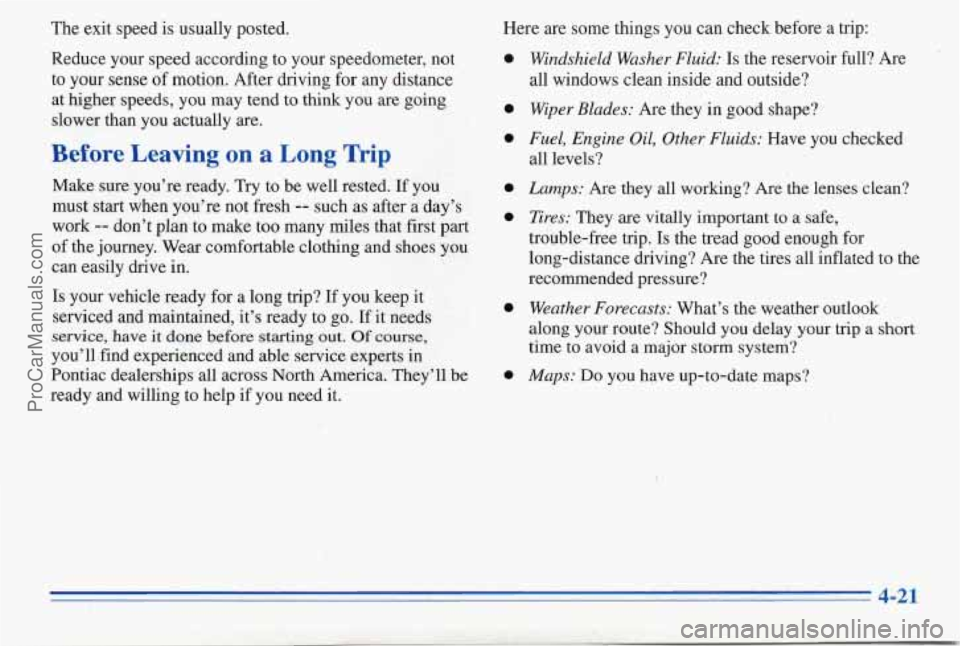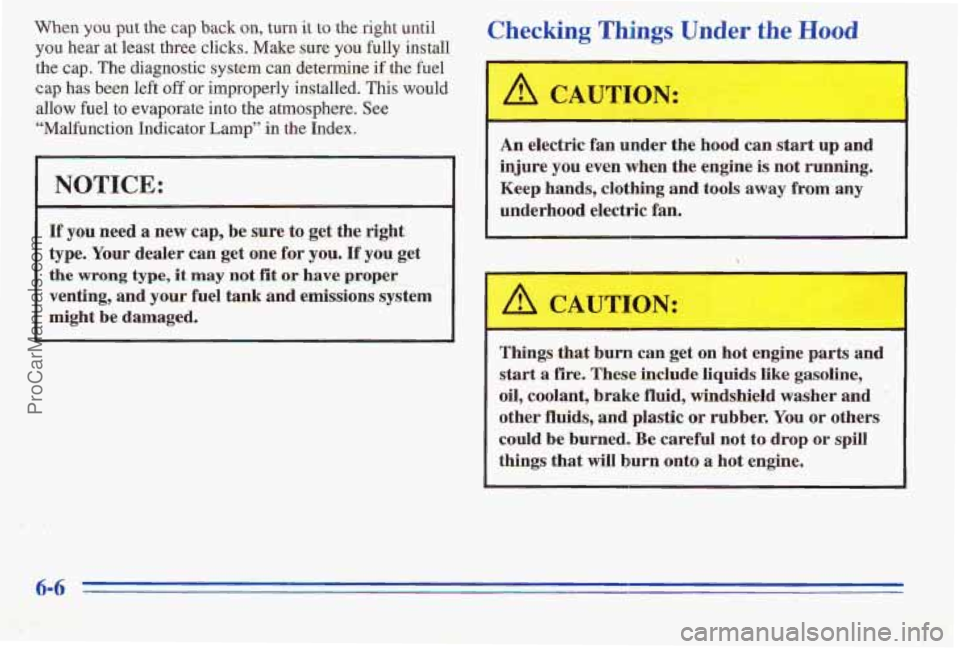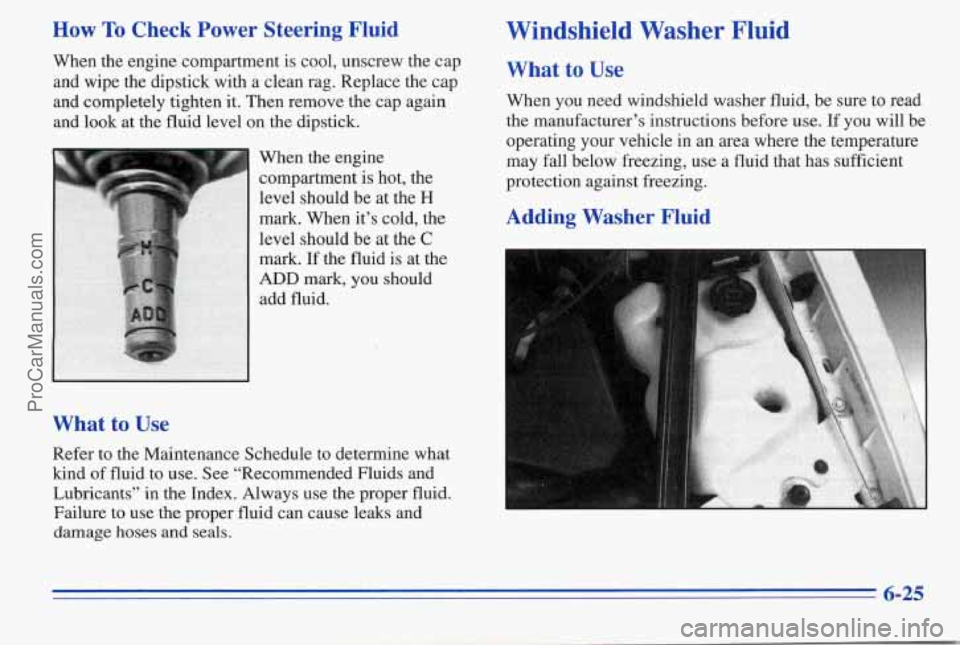Page 97 of 370

Windshield Wipers
You. control the windshield
wipers
by tuning the band
marked WIPER. Fora
single wiping cycle,
turn the
band to
MIST. Hold it there
until
the wipers start; then
let
go. The wipers will stop
dter-one cycle.
If you want.
more. cycles, hold the band
on
MIST longer.
For steady wiping at low speed, turn the band to LO. For
high-speed wiping, turn
the band’ further, to HI. To stop
You can set the wiper speed for a long or short delay
between wipes.
This can be very useful in light rain or
snow. Turn the band to choose the delay time. The
closer
to LO, the shorter the delay.
Be sure to clear ice and snow
from the wiper blades
before using th&n. If they’re Frozen,to the windshield,
carefully loosen or thaw them. If your blades do become
damaged, get new blades or blade inserts.
the wipers, turn the band to OW.
Heavy snow or ice can overload your wipers. A circuit
breaker will stop them until the motor cools. Clear away
snow
or ice to prevent an overload.
Windshield Washer
At he top of the multifunction lever, there’s a paddle
with the word
PUSH on it. To spray washer fluid on the
windshield,
push the paddle. The wipers will run far
several sweeps and then either stop
or return to your
preset speed.
,
I
In freezing weatll=r, don’t use your washer until
the
windshield is warmed. Otherwise the washer
fluid can form ice on the windshield, blocking
your
vision.
ProCarManuals.com
Page 171 of 370

Driving in Rain and on Wet Roads Rain and wet roads can mean driving trouble. On a wet
road, you can’t stop, accelerate or turn as well because
your tire-to-road traction isn’t as good as
on dry roads.
And, if your tires don’t have much tread left, you’ll get
even less tractiqn.
It’s always wise to go slower and be
cautious
if rain starts to fall while you are driving. The
surface may get wet suddenly when
your reflexes are
tuned for driving on dry pavement.
I The heavier the rain, the harder it is to see. Even if your
windshield wiper blades
are in good shape, a heavy rain
can make
it harder to see road signs and traffic signals,
pavement markings, the edge
of the road and even
people walking.
It’s wise to keep your windshield wiping equipment in
good shape and keep your windshield washer tank filled
with washer fluid. Replace your windshield wiper
inserts when
they show signs of streaking or missing
areas on the windshield, or when strips
of rubber start to
separate from
the inserts.
4.16
ProCarManuals.com
Page 176 of 370

The exit speed is usually posted.
Reduce your speed according to your speedometer, not
to your sense of motion. After driving for any distance
at higher speeds, you may tend to think you are going
slower than you actually
are.
Before Leaving on a Long Trip
Make sure you're ready. Try to be well rested. If you
must
start when you're not fresh -- such as after a day's
work
-- .don't plan to make too many miles that first part
of the journey. Wear comfortable clothing and shoes you
can easily drive in.
Is your vehicle ready for a long trip? If you keep it
serviced and maintained, it's ready to go. If it needs
service, have it done before starting out. Of course,
you'll.find experienced and able service experts in
Pontiac dealerships all across
North America. They'll be
ready and willing to help if you need it. Here are some things
you can check before a trip:
0
0
0
a
a
0
a
Windshield Washer Fluid: Is the reservoir full? Are
all windows clean inside and outside?
Wiper Blades:
Are they'in good shape?
Fuel, Engine Oil, Other Fluids: Have you checked
all levels?
Lamps: Are they all working? Are the lenses clean?
Tires: They are vitally important to a safe,
trouble-free trip.
Is the tread good enough for
long-distance driving?
Are the tires all inflated to the
recommended pressure?
Weather Forecasts: What's the weather outlook
along your route? Should you delay your trip a
short
time to avoid a major storm system?
Maps:
Do you have up-to-date maps?
4-21
ProCarManuals.com
Page 179 of 370
Winter Drivi: -
Here are some tips for winter driving:
Have your Pontiac in good shape for winter.
YOU may want to put winter emergency supplies in
your trunk. Include
an ice
scraper, a small brush or broom, a supply
of windshield washer fluid, a rag, some winter outer
clothing, a small shovel, a flashlight, a red cloth and a
couple
of reflective warning triangles. And, if you will
be driving under severe conditions, include a small bag
of sand, a piece of old carpet or a couple of burlap bags
to help provide traction. Be sure you properly secure
these items in your vehicle.
ProCarManuals.com
Page 233 of 370

When you put the cap back on, turn it to the right until
you hear at least three clicks. Make sure you €ully install
the cap. The diagnostic system can determine if the fuel
cap has been left off or improperly installed. This would
allow he1 to evaporate into the atmosphere. See
"Malfunction Indicator
Lamp" in the Index.
NOTICE:
I€ you need a new cap, be sue to get the right
type. Your dealer can get one for
you. If you get
the wrong type, it may not fit or have proper
venting, and
your fuel t&-@nd gmissions system
might be damaged. . ...._ ,. . 4.~*,-.:~7F4c:> i,,:;:r'.&:;.., I 5 .v,<. " 52;:. .' , "" $g7!fnt ,,
Checking Things Under the Hood
An electric fan under the hood can start up and
injure
YOU even when the engine is not running.
Keep hands, clothing and tools away from any
underhood electric fan.
Things
that burn can get on hot engine parts and
start a fire. These include liquids like gasoline,
oil, coolant, brake fluid, windshield washer and "
other fluids, and plastic or rubber. You or others
could
be burned. Be careful not to drop or spill
things
that will burn onto a hot engine.
~ ~~~
ProCarManuals.com
Page 235 of 370
When you lift the hood of the 3.1L L82 engine, you’ll see:
A. Engine Coolant Reservoir
B. Radiator Fill Cap
C. Power Steering Fluid Reservoir
D. Engine Oil Fill Cap
E. Engine Oil Dipstick
E Automatic Transaxle Dipstick
G. Brake Fluid Reservoir
H. Air Cleaner
I. Windshield Washer
Fluid Reservoir
J. Battery (located under
Windshield Washer
Fluid Reservoir)
6-8
ProCarManuals.com
Page 236 of 370
When you lift the hood of the 3.4L LQl engine, you’ll see:
1
A. Engine Coolant Reservoir
B. Radiator Fill Cap
C. Power Steering Fluid Reservoir
D. Engine Oil Fill Cap E.
Engine Oil Dipstick
F. Automatic Transaxle Dipstick
G. Brake Fluid Reservoir
H. Air Cleaner
I. Windshield Washer
Fluid Reservoir
J. Battery (located under
Windshield
Washer
Fluid Reservoir)
6-9
ProCarManuals.com
Page 252 of 370

How To Check Power Steering Fluid
When the engine compartment is cool, unscrew the cap
and wipe the dipstick with a clean rag. Replace the cap
and completely tighten it. Then remove the cap again
and
look at the fluid level on the dipstick.
When the engine compartment is hot, the
level should be at the
H
mark. When it’s cold, the
level should be at the
C
mark. If the fluid is at the
ADD mark, you should
add fluid.
What to Use
Refer to the Maintenance Schedule to determine what
kind of fluid to use. See “Recommended Fluids and
Lubricants”
in the Index. Always use the proper fluid.
Failure to use the proper fluid can cause leaks and
damage hoses
and seals.
Windshield Washer Fluid
What to Use
When you need windshield washer fluid, be sure to read
the manufacturer’s instructions before use. If you will be
operating your vehicle in an area where the temperature
may fall below..freezing, use a fluid that has sufficient
protection against freezing.
Adding Washer Fluid
ProCarManuals.com